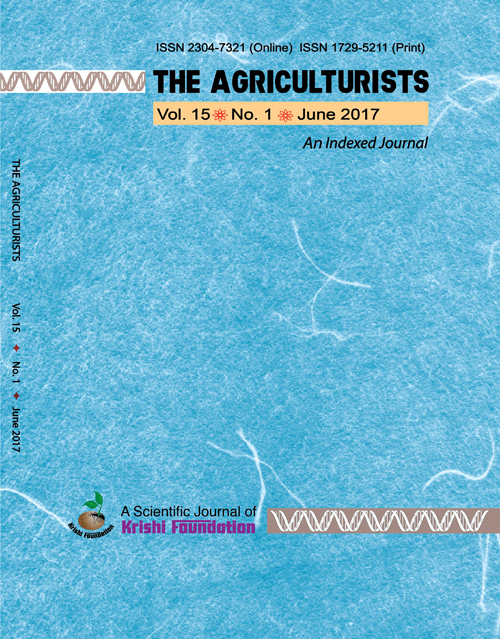Selection of Core Collection from <i>Jesso-Balam</i> Rice (<i>Oryza sativa</i> L.) Accessions Using Quantitative, Qualitative and Molecular Characters-A Review
DOI:
https://doi.org/10.3329/agric.v15i1.33440Keywords:
Rice, Jesso-Balam, characterization, core collection.Abstract
Genetic improvement of rice (Oryza sativa L.) for yield is important for increasing demand of the growing population and the changing climate of the world. Recent studies showed that backcrossing twice using modern varieties as receptor and mini core collection as doner, most of the undesirable traits could be improved remarkably and in other words its maximum allele diversity could be brought back into rice fields. Core collection is defined as a subset chosen to represent the most genetic diversity of an initial collection with a minimum of redundancies. The objective of the present study was to review the selection of core collection of Jesso-Balam group of rice genotypes through quantitative, qualitative and molecular characters. Earlier, the same germplasms were characterized for agro-morphological, physico-chemical and molecular characters and grouped into different clusters by different methods at Bangladesh Rice Research Institute during 2009-12. Finally, the core collection was selected by reviewing the above characterized data and using the hierarchical cluster analysis. Moreover, the selection processes of core collection were improved by applying composite evaluation methods; such as agro-morphological traits, biochemical characters and so on, through sampling strategies based on genotypic values, predicted genotypic value, comparing different genetic distances, cluster methods and sampling strategies methods, molecular characterization or SSR marker base data. As a result, the selected core germplasm of Jesso-Balam rice accessions were JBPL1, JBPL8, JBPL9, JBPL10, JBPL13, JBPL15, JBPL16, JBPL17, JBPL19, JBPL20, JBPL21, JBPL23, JBPL25 and JBPL26. In conclusion, the core collection need to be considered as the working collection of Jesso-Balam rice genotypes for their easy and safe conservation and effective utilization in Gene bank.
The Agriculturists 2017; 15(1) 170-181
Downloads
116
166

